How to make sourdough starter
The path to great sourdough bread begins with healthy starter.
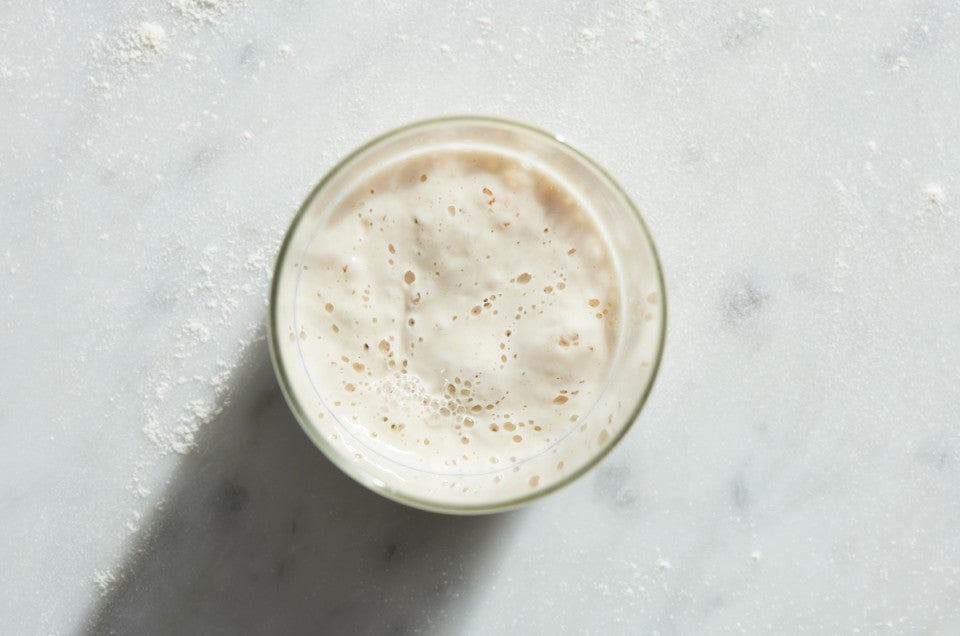

Have you ever wondered how to make sourdough starter?
Whether it conjures up a crusty loaf of bread or a bubbling crock of starter, sourdough is a treasured part of many bakers’ kitchens. But where does the path to sourdough bread begin? And how do you start?
Start in your own home kitchen, with flour and water. And begin by learning how to make your own sourdough starter.
First, a word of advice. Sourdough baking is as much art as science. This method for making sourdough starter isn't an exact match for the one you read on another site, or in a cookbook, or in your great-grandma's diary. If you have a process you've successfully followed before, feel free to stick with it. Or try this one and compare.
The following timeline assumes you can find a relatively warm place (68°F to 70°F) to grow your starter. More on that below. We also highly recommend using a scale: It will make this process much more accurate and much less messy. (But using measurement cups works, too, if necessary.)
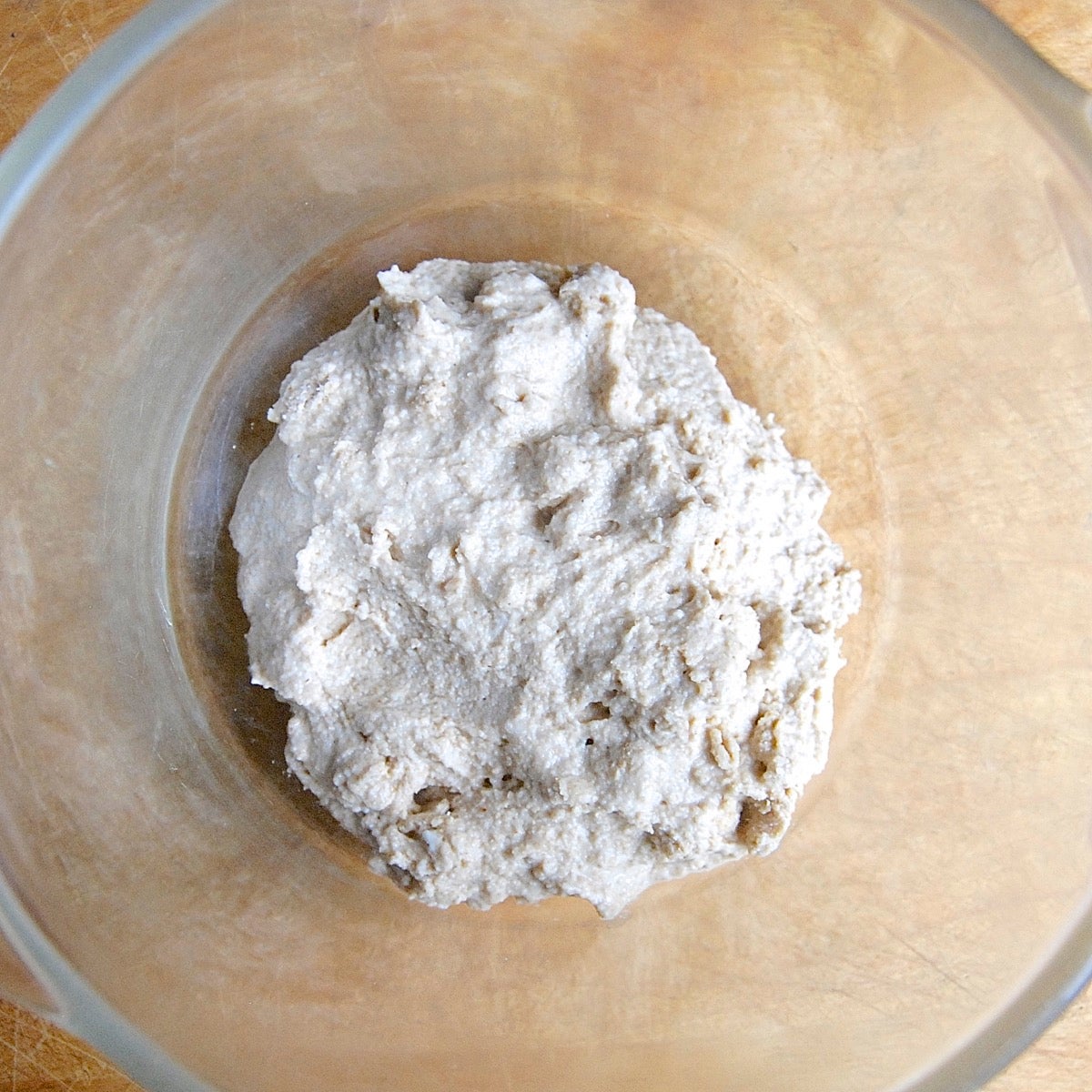
Combine 113g (1 cup) whole rye flour (pumpernickel) or whole wheat flour with 113g (1/2 cup) non-chlorinated cool water in a non-reactive container. Glass, crockery, stainless steel, or food-grade plastic all work fine for this. Stir everything together thoroughly; make sure there's no dry flour anywhere. Cover the container loosely and let the mixture sit at warm room temperature (about 70°F) for 24 hours.
A note about flour: You'll notice whole grain flour (whole wheat or rye) is used at the beginning of the process. This is because whole grains contain more nutrients and sourdough-friendly microorganisms than all-purpose flour. (Learn more in our post: Sluggish starter? Add a little whole grain flour.) After this first day, switch to using all-purpose flour.
A note about water: You also may have better results if you feed your starter with non-chlorinated cool water; from now on, we'll refer to this simply as "water."
A note about room temperature: The colder the environment, the more slowly your starter will grow. If the normal temperature in your home is below 68°F, we suggest finding a smaller, warmer spot to develop your starter. For instance, try setting the starter near a baseboard heater, or atop your water heater, refrigerator, or another appliance that might generate ambient heat. Your oven, turned off but with the light on, is another option, as is setting the container of starter on a folded dish towel laid atop a heating pad on its lowest setting. A temperature-controlled bread proofer or a sourdough home is the absolute ideal solution; if you bake lots of bread, consider investing in one of these tools.
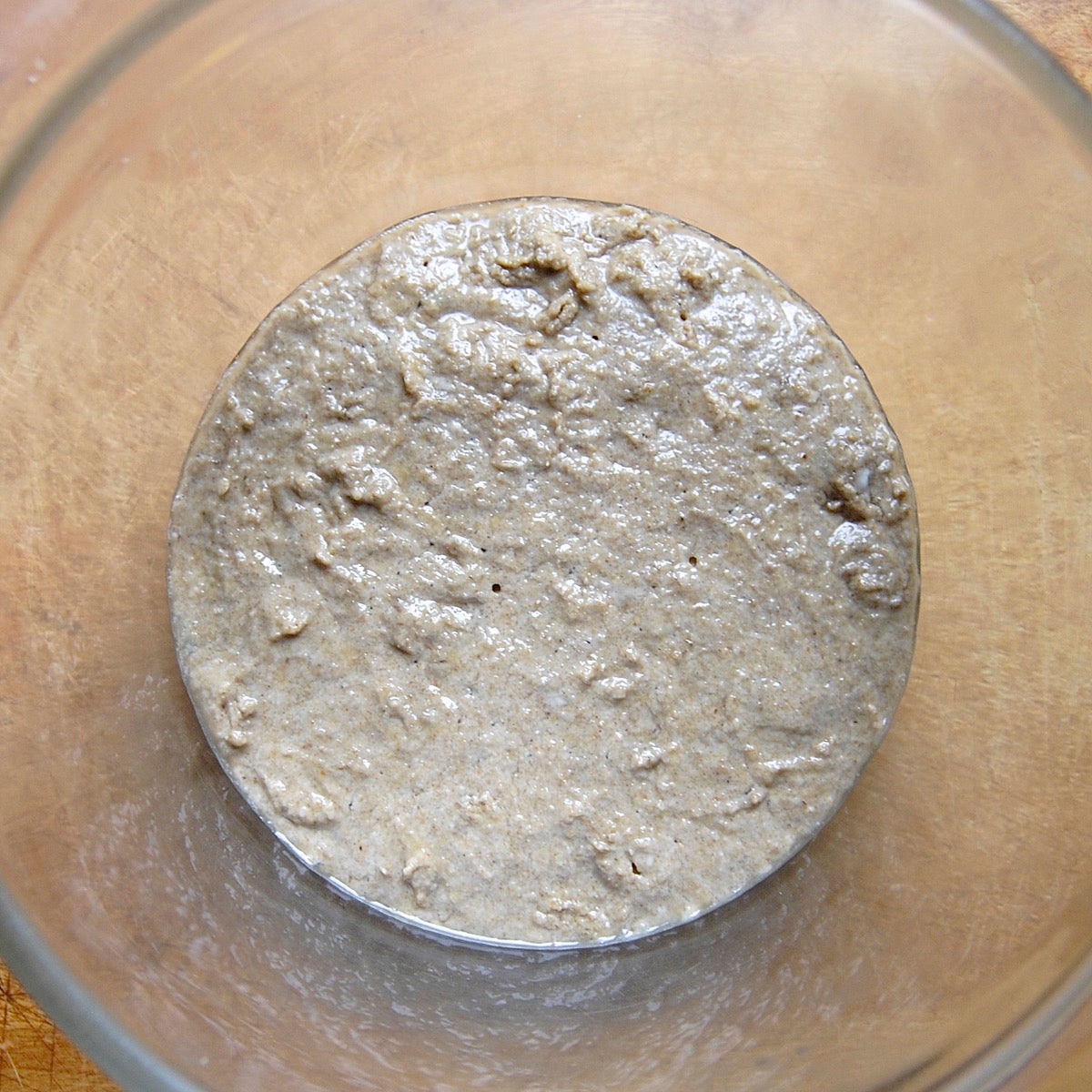
You may see no activity at all in the first 24 hours, or you may see a bit of growth or bubbling. Note that this starter looks fairly inert when viewed from up top.
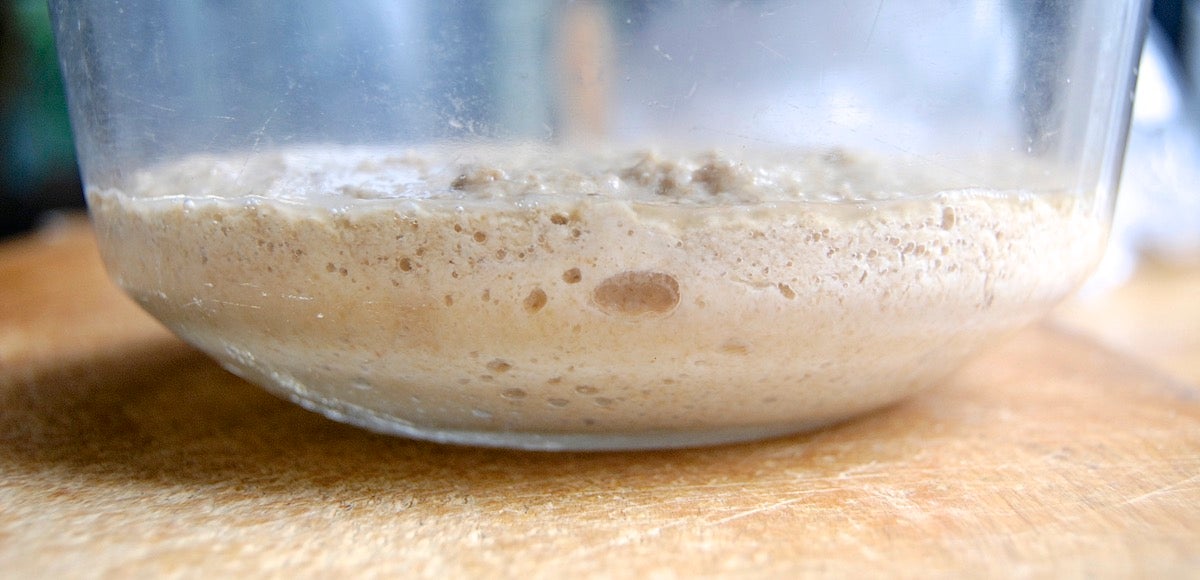
But when viewed from the side, you can see bubbles starting to form under the surface.
Either way, discard half the starter (113g; about 1/2 cup), and add to the remainder 113g (a scant 1 cup) King Arthur Unbleached All-Purpose Flour and 113g (1/2 cup) cool water (if your house is warm); or lukewarm water (if it's cold). Mix well, cover, and let the mixture rest at room temperature for 24 hours.
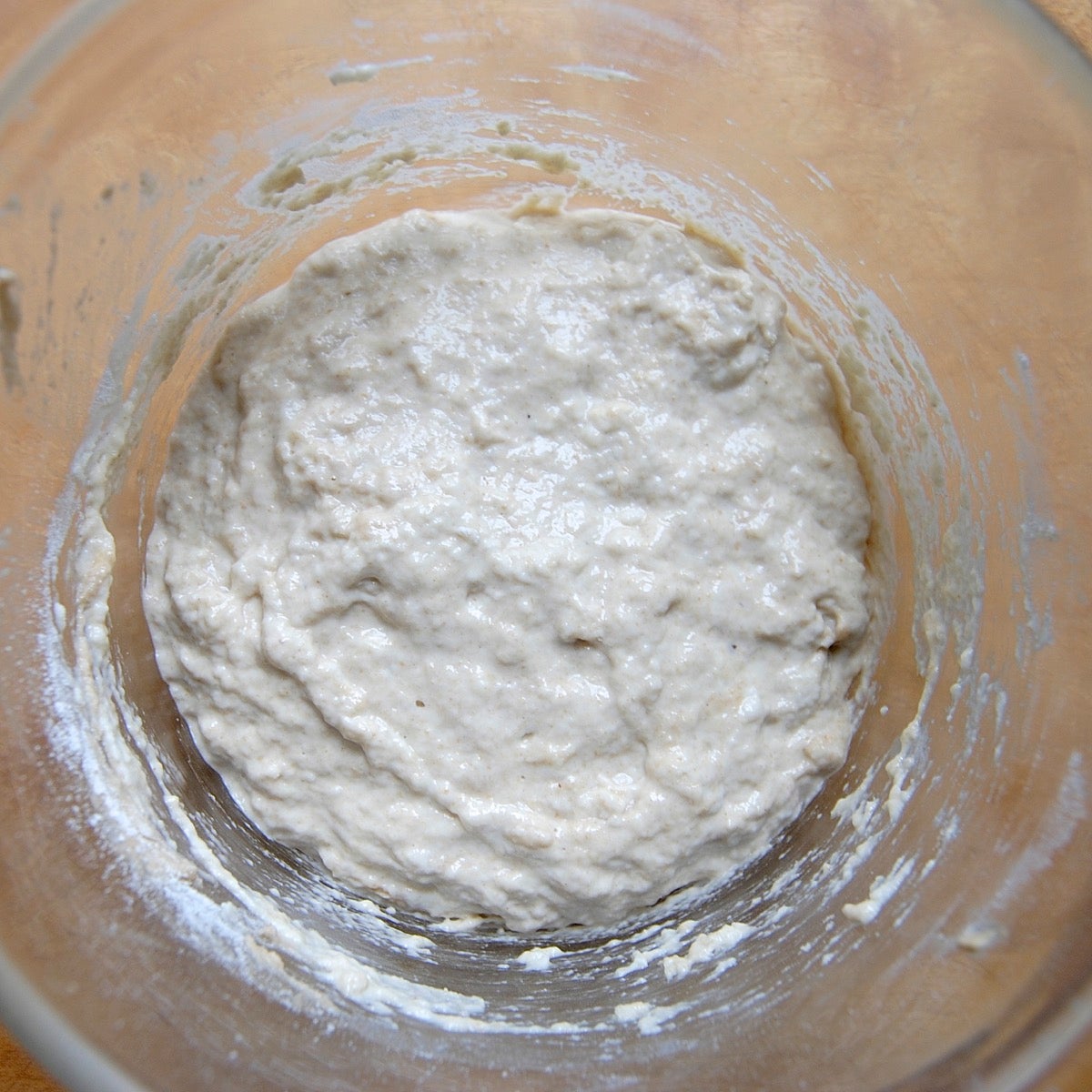
It's necessary for three reasons. First, unless you discard, eventually you'll end up with way too much starter. Second, keeping the starter volume the same helps balance the pH. And third, keeping the volume down offers the yeast more food to eat each time you feed it; it's not fighting with quite so many other little yeast cells to get enough to eat.
Also, you don't have to discard it if you don't want to; you can give it to a friend, or use it to bake. There are quite a few recipes on our site using "discard" starter, including sourdough pizza crust, sourdough pretzels, and my all-time favorite waffles. And if you still aren't comfortable discarding so much, consider maintaining a smaller sourdough starter.
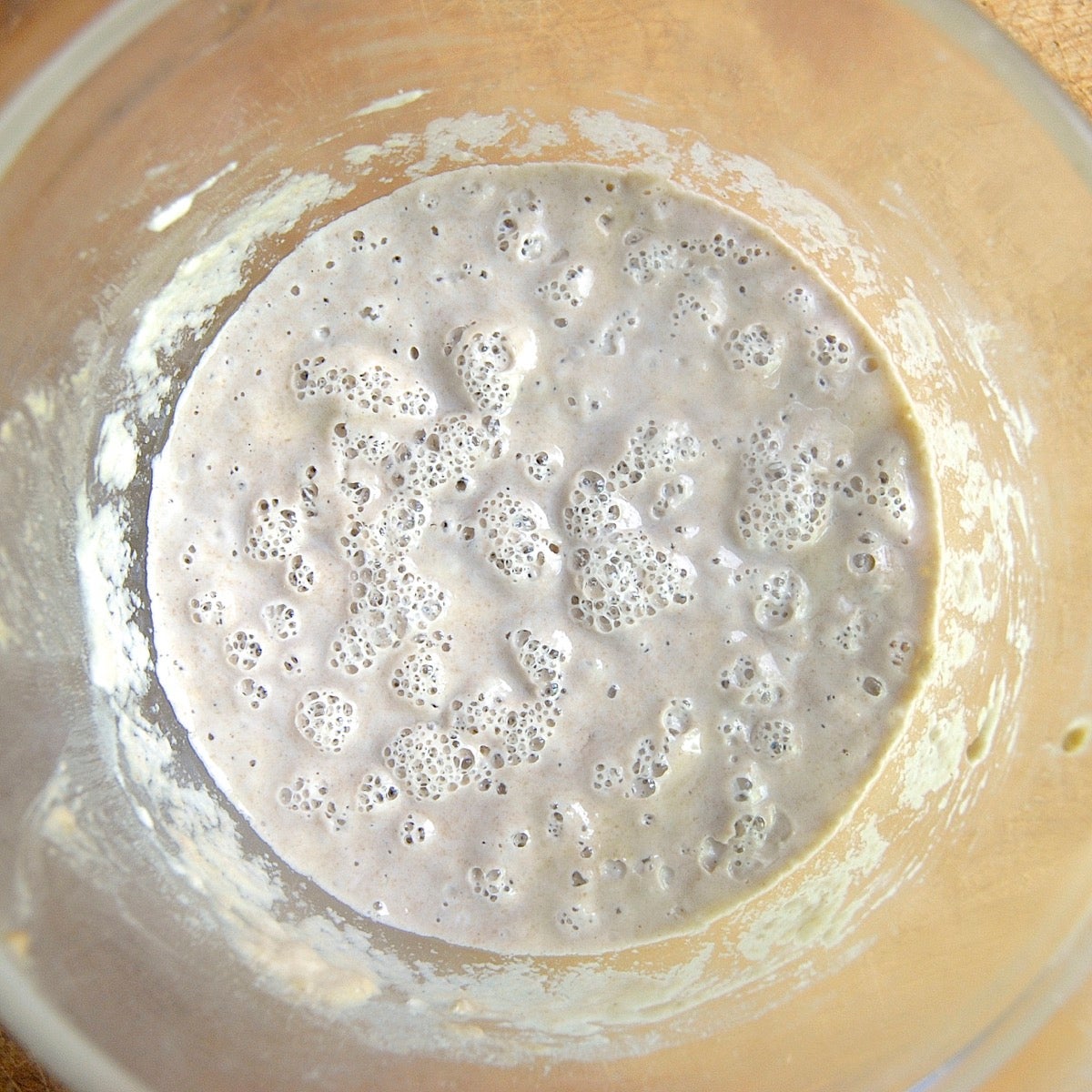
By the third day, you’ll likely see some activity — bubbling; a fresh, fruity aroma; and some evidence of expansion. The somewhat darker hue your starter got from its whole wheat beginnings will fade as you continue to feed it with all-purpose flour. It’s now time to begin two feedings daily, as evenly spaced as your schedule allows.
For each feeding, weigh out 113g starter; this will be a generous 1/2 cup, once it’s thoroughly stirred down. Discard any remaining starter.
Add 113g (a scant 1 cup) King Arthur Unbleached All-Purpose Flour and 113g (1/2 cup) water to the 113g starter. Mix the starter, flour, and water, cover, and let the mixture rest at room temperature for approximately 12 hours before repeating.
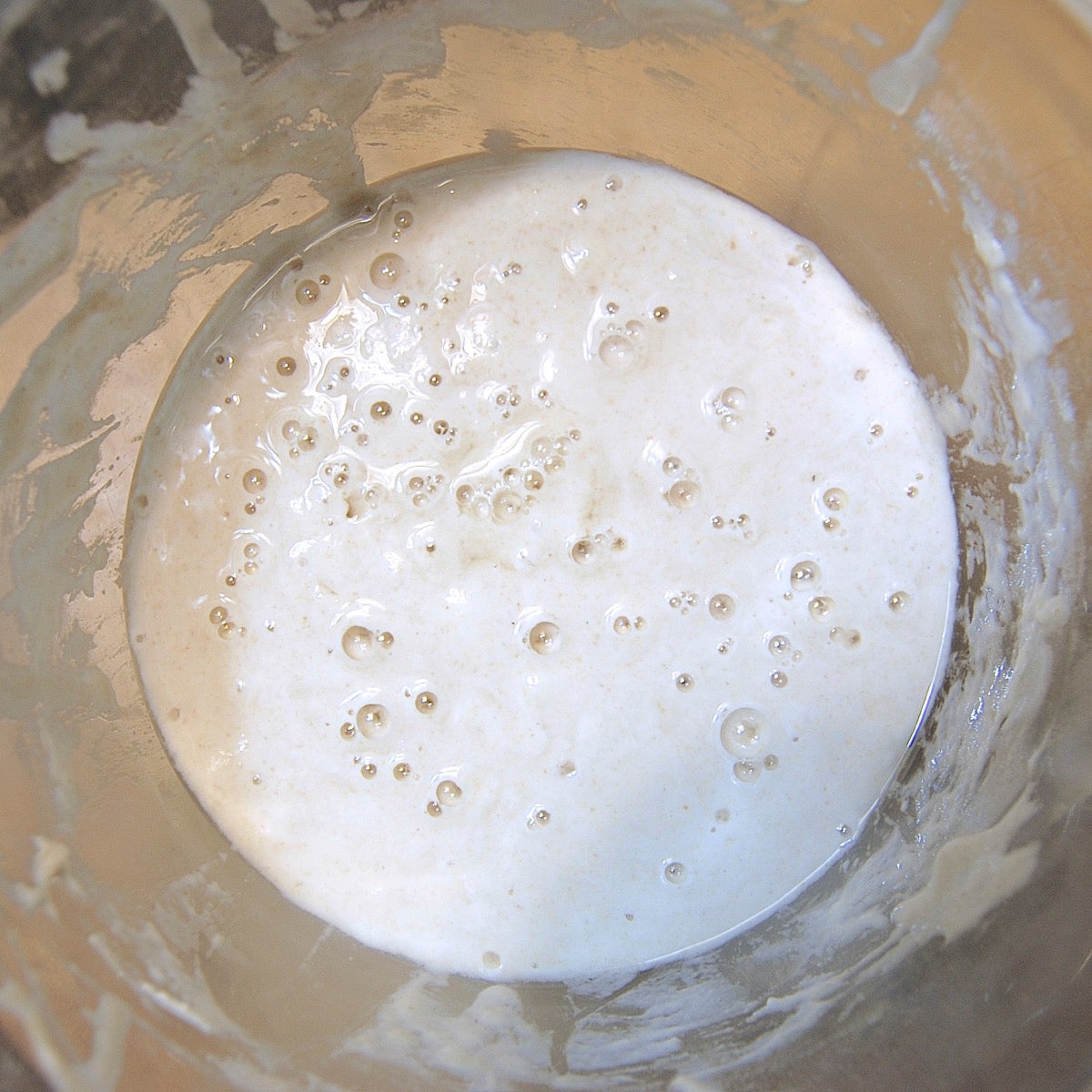
Here's the starter after its 12-hour rest. It may actually appear to be bubbling less than it did initially; this is normal.
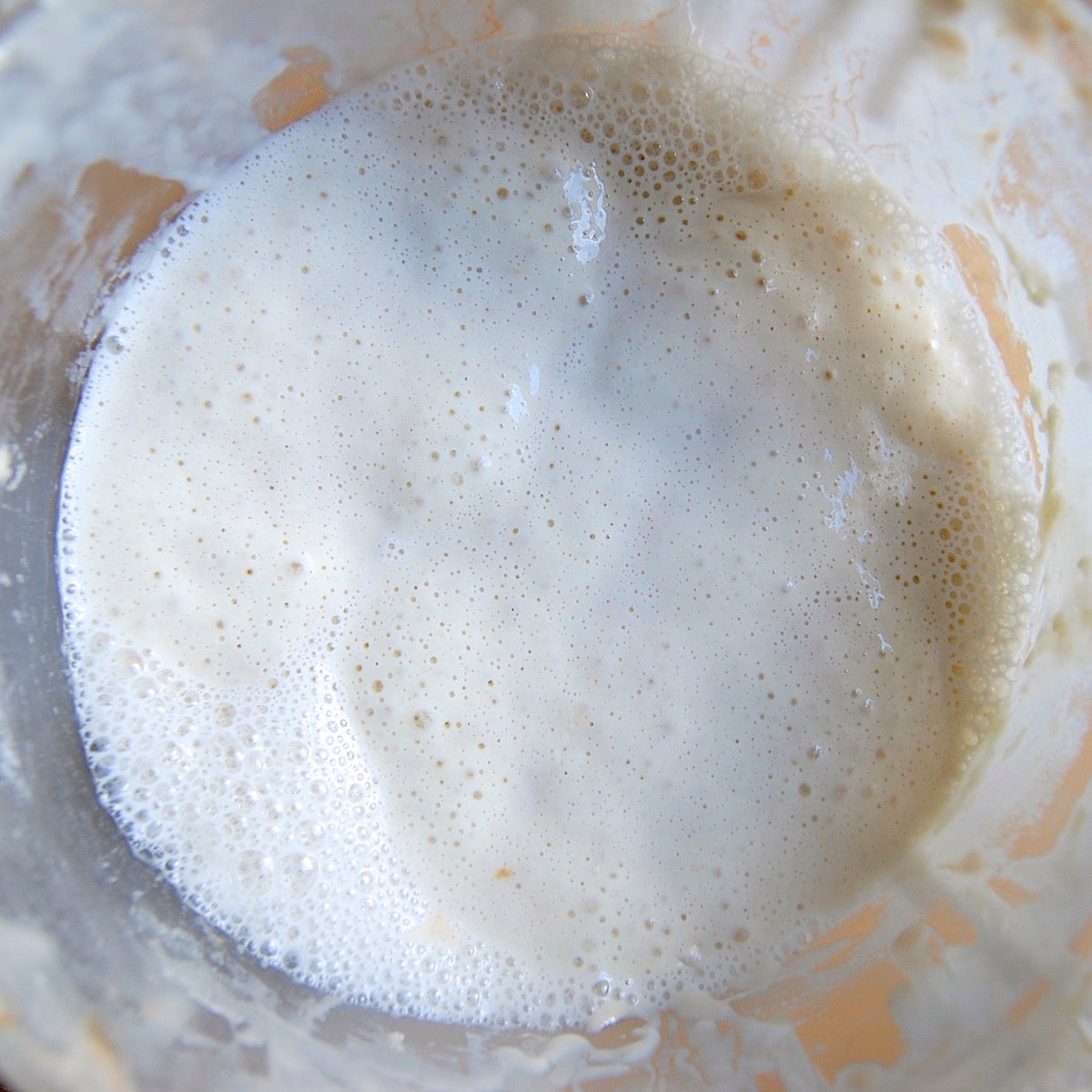
Repeat two-a-day feedings on days 4, 5, and as many days as it takes for your starter to become very active — almost foamy. If your starter is in cool surroundings, you may find it takes up to 2 weeks (or perhaps even longer) to get going.
When it shows a markedly different type of bubbling, though, it's just about ready to use.
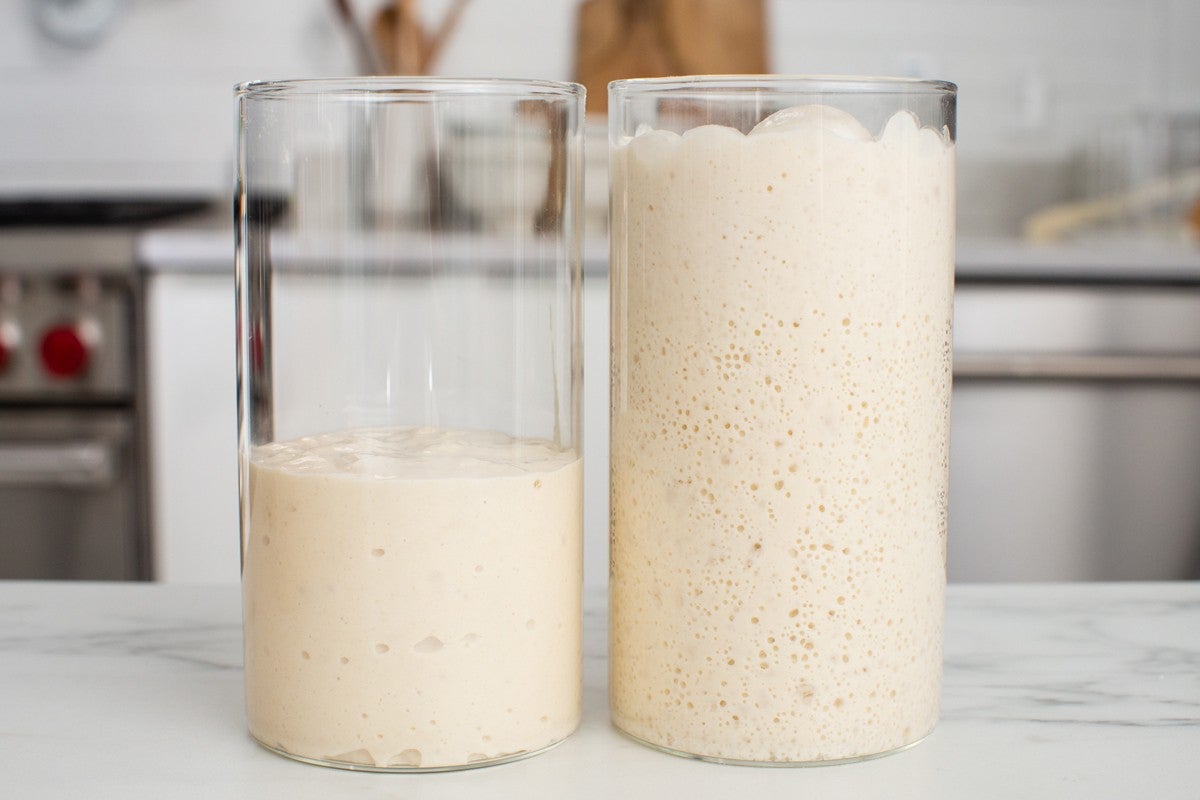
When you stir it down and feed it this time, make a note of how high it comes on the bowl or jar. You'll know it's ready to use in baking when it doubles in size in about 4 to 6 hours. You'll see lots of bubbles; there may be some little “rivulets” on the surface, full of finer bubbles. The starter should also have a tangy aroma — pleasingly acidic, but not overpowering.
When it gets to this point — doubling in size in 4 to 6 hours — give it one last feeding. Discard all but 113g (a generous 1/2 cup). Feed as usual. Let the starter rest at room temperature for 4 to 8 hours; it should be active, with bubbles breaking the surface.
Remove however much starter you need for your recipe (no more than 227g, about 1 cup); and transfer the remaining 113g of starter to its permanent home: a crock, jar, or whatever you'd like to store it in long-term. Feed this 113g of starter with 113g of flour and 113g of water.
Let it bubble and become active for several hours before covering it and placing it in the refrigerator.
No worries. If, after a week, your starter isn’t ready, don’t lose heart; keep feeding it regularly, and it will gain strength — really! Be patient. The conditions in your kitchen may be more or less conducive to building a starter, depending on room temperature, the season, humidity, or how much you’ve been baking.
Remember, the keys to developing a successful starter are:
Once your starter is doubling in size six to eight hours after being fed, it's ready to start baking. Here's what it should look like:
Now you're ready to bake with your starter! Try one of these beginner-friendly recipes:
No-Knead Sourdough Bread: This low-technique recipe relies entirely on sourdough starter for leavening. With a bubbly, active sourdough starter, a little bit of patience, and minimal effort, you’ll have a stunning, delicious loaf — all made without kneading.
Pain de Campagne (Country Bread): If you’re looking for a bit more of a challenge, try this recipe. Using unfed sourdough starter, minimal kneading, long fermentation, and baking in a hot Dutch oven are some of the techniques that make this naturally leavened, bakery-quality loaf simple to make at home.
Rustic Sourdough Bread: Because this recipe includes commercial yeast as well as starter, you're guaranteed a good, strong rise — even if your starter isn't quite up to snuff. If you’re just beginning to bake with sourdough starter and want some extra reassurance of success, this loaf is a great choice.
Note: In these recipes “ripe sourdough starter” refers to starter that has been fed and then doubled in volume and is showing signs of just beginning to sag under its own weight. The timing will be different depending on your sourdough starter and conditions, but generally, this occurs roughly eight hours after being fed. See more: Ripe sourdough starter: Here's what that means.
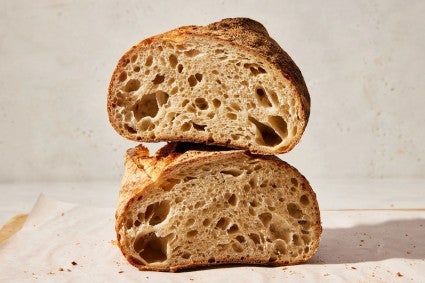
Don't worry — everything will be just fine. Starter is remarkably resilient. If you missed one feeding, just pick back up with your typical routine and your starter will settle in easily. If you missed a few feedings, simply keep feeding at room temperature every 12 hours until it doubles in size within 4 to 8 hours. Learn more in our post: What if I forgot to feed my starter?
Sourdough starter should smell sharply sour but "clean," with no overtones of spoilage, or any oddly chemical smell (think acetone). While the aroma of sourdough may make you draw back simply from its strength, it shouldn't be distasteful.
When your starter is neglected for an extended period, the liquid on top tends to turn from clear to dark-colored. That's OK; simply stir the liquid back into the starter and feed it the meal it's desperately craving. However, if your starter shows visible signs of mold, or an orange or pink tint/streak, or smells putrid, throw it out; it's been invaded by harmful microorganisms, and it's time to start over.
Want something printable to follow? See our recipe for Sourdough Starter.
Next: Maintaining your starter
Cover photo by Mark Weinberg; food styling by Liz Neily.
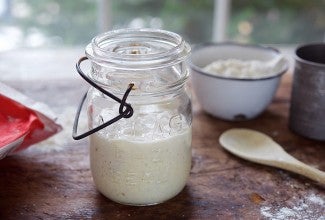


March 19, 2023 at 3:06pm
I have not done this starter yet but want to know if your bread flour is ok to use instead of all purpose?
March 20, 2023 at 4:48pm
In reply to I have not done this starter… by Linda (not verified)
You will get slightly different results, Linda, but yes you can use an unbleached bread flour. Your starter will be a little thicker and the rise times might be a bit different, but it should be reasonably close to the textures and times listed in our sourdough information.
March 6, 2023 at 10:38pm
Made a starter with this formula and in my 71 degree house it worked but not that well. I tossed my first try and then put my starter in a 78 degree area and my day 1 starter had lots of bubbles under the top that were visible from the sides of the container. In a colder temp I’d recommend the day 1 end when the starter has some bubbles rather than end day 1 after 24 hours period. I believe the initial fermentation at 71 degrees did not generate enough good yeast and stuff to make a strong enough starter even after 12 days, just my experience…
March 7, 2023 at 2:44pm
In reply to Made a starter with this… by Petros (not verified)
Thanks for taking the time to put your experience with sourdough out there for all of us to read, Petros! We really appreciate the care that you put into your starting and our community of bakers. Glad to hear that you found a method that works so well and hopefully someone else can give it a try if they find themselves having trouble as well!
February 21, 2023 at 5:22pm
Can I use only Whole Wheat flour to create sourdough starter?
February 22, 2023 at 4:44pm
In reply to Can I use only Whole Wheat… by Bittu (not verified)
Hi Bittu, you can certainly use solely whole wheat flour for you starter. You may notice you need to add a few additional TBSP of water as whole wheat tends to soak up more liquid. Happy Baking!
January 19, 2023 at 10:39pm
You reference flour measurements as 'one scant cup (4 ounces)". Except 1 cup is 8 ounces, 1/2 cup is 4 ounces. Could you please explain this for me? Thank you.
January 22, 2023 at 10:32am
In reply to You reference flour… by Cathie (not verified)
While one cup is 8 ounces by volume, it depends on the ingredient being measured when speaking one cup by weight. Each ingredient weighs a different amount even though they all fill one cup of space, Cathie. Think of feathers and stones- one cup of feathers will weigh quite a bit less than a cup of stones but they both will be one cup. Here's a link to our ingredient weight chart for a list of the weight of the most common baking ingredients. Hope it helps!
January 29, 2023 at 1:26pm
In reply to While one cup is 8 ounces by… by mperry
i am confused as well with the same questions. your website recommended weighting the ingredients, all of your sourdough bread recipes are using grams but the sourdough starter recipe uses cups and oz. and you refer us to use an ingredient weight chart to convert? why?
I just got out of 227g of starter to bake the bread the recipe calls for 1 cup (227g) however, I use a standard US cup the 227 g doesn't equal to 1 cup. so your recipe should convert to grams instead of cups/oz for the consistency of your website/recipes. the starter recipe just confusing for beginners,
February 4, 2023 at 12:26pm
In reply to i am confused as well with… by Austin (not verified)
Hi Austin, we've updated the Sourdough Starter recipe as well as the Feeding and Maintaining Your Sourdough Starter recipe online to include gram weights, so I hope you'll find these easier to follow, and I will pass along your request that the blog post be updated to include gram weights as well. As far as a cup of sourdough starter weighing 227g goes, the weight of a cup of starter can vary a bit, depending on the consistency of the starter, how ripe it is, and whether or not it was stirred down before measuring, so it's not surprising you came up with a slightly different weight. You're right to stick with grams if you have a scale, as this is the most accurate way to measure your ingredients, but because some folks don't have scales we do include the cup measurements as well. When measuring ripe starter by cups we recommend stirring it down before measuring, but when measuring by grams there's no need to stir it down.
Pagination